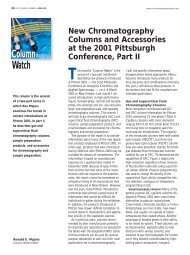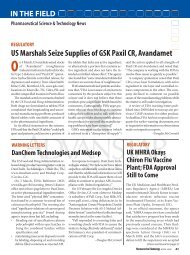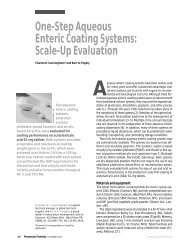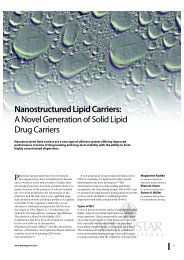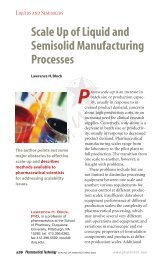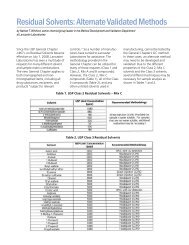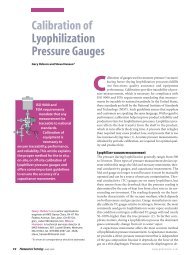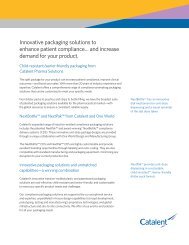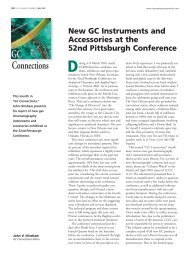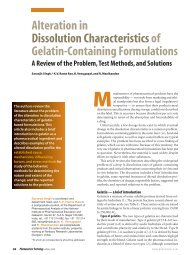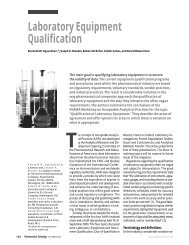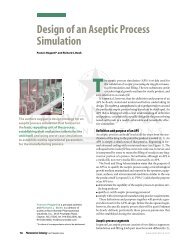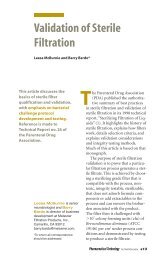Frequently Asked Questions - Pharmaceutical Technology
Frequently Asked Questions - Pharmaceutical Technology
Frequently Asked Questions - Pharmaceutical Technology
Create successful ePaper yourself
Turn your PDF publications into a flip-book with our unique Google optimized e-Paper software.
2 <strong>Frequently</strong> <strong>Asked</strong> <strong>Questions</strong><br />
3. What are the main benefits of using Carbopol ® polymers in controlled release matrix tablets?<br />
The main benefits of using Carbopol ® polymers in controlled release matrix tablets are as follows:<br />
• Highly efficient at low polymer levels (typical use levels are 3 – 30%), enabling smaller tablet sizes and overall formulation<br />
cost savings.<br />
• Provides flexibility in achieving a target release profile by varying the polymer level in the formulation. Compared to<br />
cellulosic materials, the drug release profile from a Carbopol ® polymer matrix can be more easily modulated by changing the<br />
polymer level.<br />
• Provides good binding characteristics, thus allowing formulation of matrix tablets without the addition of a tablet binder.<br />
• Synthetic, reproducible polymer.<br />
• Provides bioadhesive properties.<br />
• Enables development of patentable technologies for product differentiation and/or life cycle extension.<br />
4. What is the difference between the designation “Carbopol ® ” polymer and “Carbomer”?<br />
Carbopol ® polymer is a product brand name of The Lubrizol Corporation. There are a variety of Carbopol ® polymer grades which<br />
differ in their performance characteristics. These grades are distinguished by a number designation following the product brand<br />
name (e.g. Carbopol ® 971P NF polymer and Carbopol ® 71G NF polymer).<br />
In contrast, “Carbomer” is one of the generic names that can be used to describe Carbopol ® polymers. Carbomer can be defined<br />
as a high molecular weight polymer of acrylic acid crosslinked with allyl ethers of polyalcohols. The United States Pharmacopeia<br />
(USP) and European Pharmacopeia (Ph. Eur.) include various carbomer monographs.<br />
5. What is the current compendial nomenclature that applies to Carbopol ® polymers?<br />
The European Pharmacopeia has only one monograph which applies to Carbopol ® polymers called “Carbomers”. Similarly, the<br />
Japanese <strong>Pharmaceutical</strong> Excipients also has a single monograph called “Carboxyvinyl Polymer”.<br />
The United States Pharmacopeia/National Formulary has several monographs for different carbomer grades. The monographs<br />
called “Carbomer XXX” (where XXX is a numerical designation) are assigned to products manufactured with the use of benzene.<br />
Additionally, there are three umbrella monographs that separate carbomer products based on polymer structure. These three<br />
monographs are “Carbomer Copolymer”, “Carbomer Homopolymer” and “Carbomer Interpolymer” and they apply to products<br />
not polymerized in benzene. The differentiation within each umbrella monograph is based on viscosity characteristics (Type A,<br />
Type B and Type C).<br />
Lubrizol Polymers for Oral Applications<br />
Pharmacopeia Monograph Compendial Name<br />
Product Trade Name Residual Solvent United States (USP/NF) Europe (Ph. Eur.) Japan (JPE)<br />
Carbopol ® Polymer<br />
71G NF Ethyl acetate Carbomer Homopolymer Type A Carbomers* Carboxyvinyl Polymer<br />
971P NF Ethyl acetate Carbomer Homopolymer Type A Carbomers* Carboxyvinyl Polymer<br />
974P NF Ethyl acetate Carbomer Homopolymer Type B Carbomers* Carboxyvinyl Polymer<br />
934P NF Benzene Carbomer 934P Carboxyvinyl Polymer<br />
Noveon ® Polycarbophil<br />
AA-1 USP Ethyl acetate Polycarbophil<br />
* The Carbomers Monograph in the European Pharmacopeia stipulates that benzene is limited to 2 ppm.<br />
6. What is the United States Pharmacopeia/National Formulary nomenclature that applied to Carbopol ® homopolymers<br />
prior to January 1, 2006?<br />
Prior to January 1, 2006, the carbomer monographs within the U.S. Pharmacopeia/National Formulary (USP/NF) were based on<br />
mucilage viscosity and residual solvent levels. The monographs did not distinguish the type of polymerization solvent.



